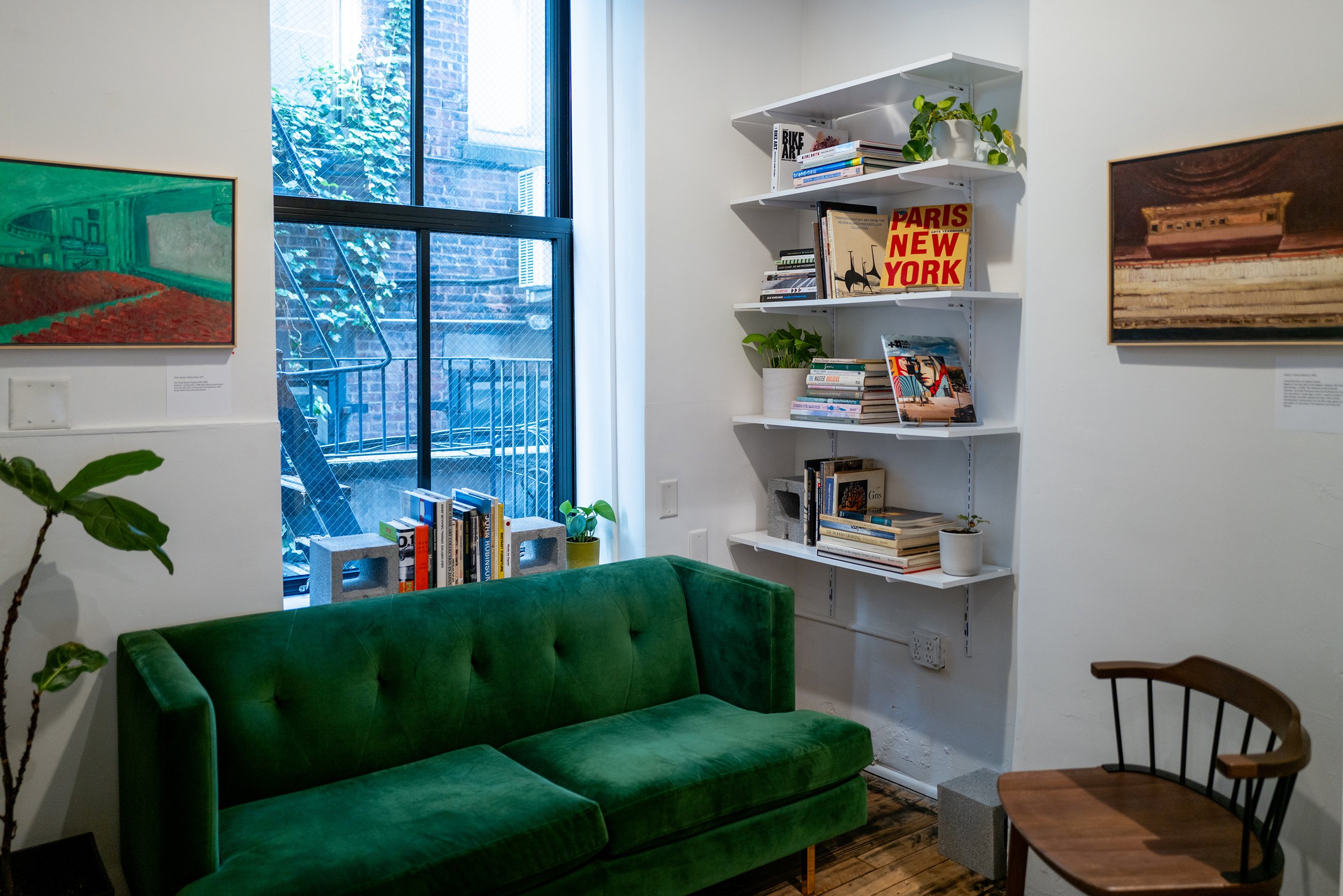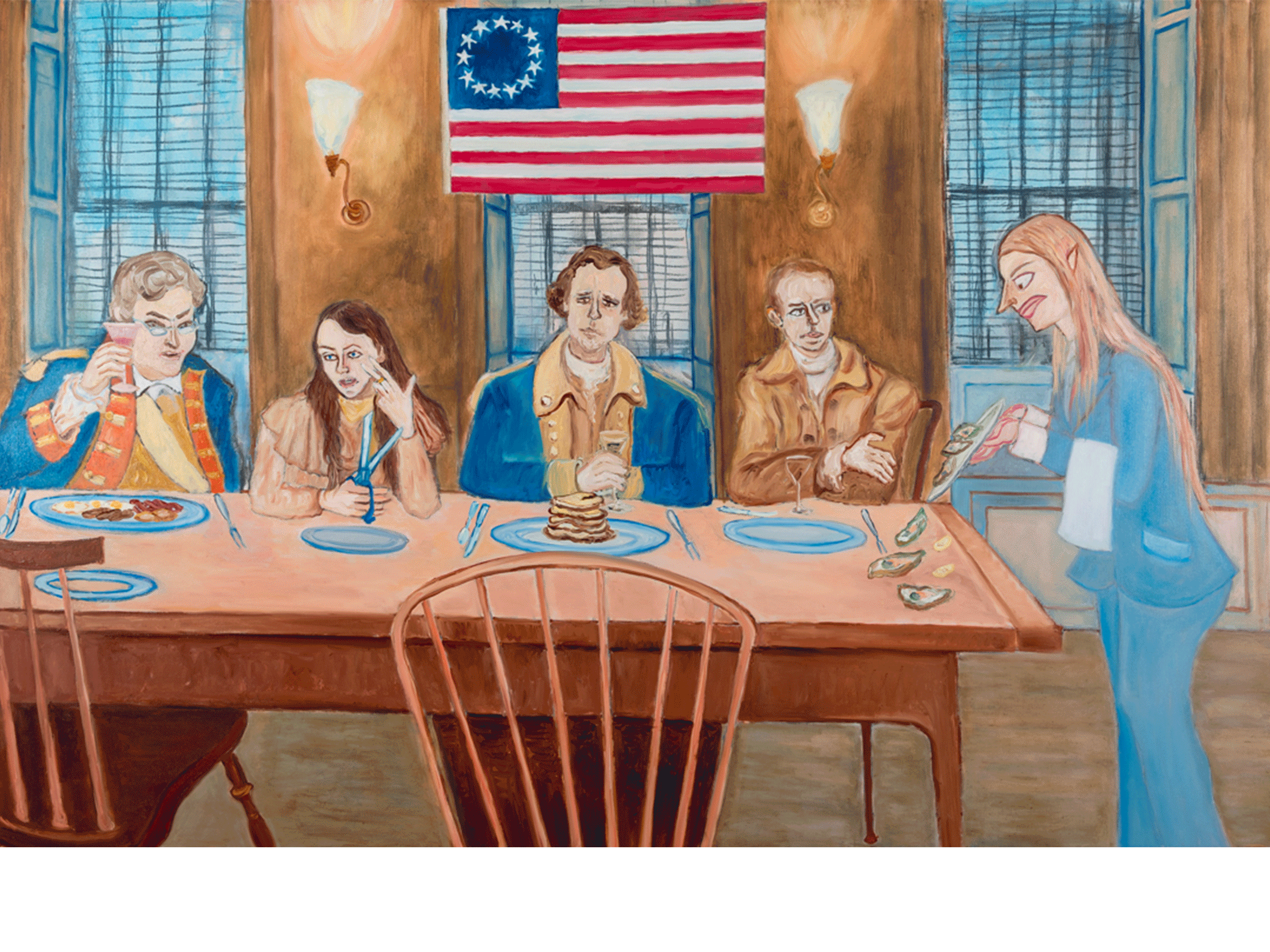TOP | EXHIBITION VIEW | INTERVIEW | ABOUT
HOME > EXHIBITIONS > YOICHIRO YODA
Yoichiro Yoda
THE CROSSING
July 27 - August 27, 2023
Thursday, July 27, 6-8pm
Click here for RSVP
Opening Reception:
An Entire Cosmology
Yoichiro Yoda is an artist who is driven, in his subject matter, by fixations and obsessions. Like a storyteller of mythic tales, he has created an entire cosmology from the topics, places, and people that prey on his mind. This pantheon includes everything from old movie palaces, to the stately days of luxury sea travel, to George Washington and his legendary deeds, to a young woman Yoda met once at a theater years ago. By deploying these things across his paintings—by bringing them to life—Yoda shows us the topology of a world of his own creation.
In Yoda’s reality, history is compressed, manipulated, and adorned. The eras of silent films and the Revolutionary War live side-by-side here, connected at first by the tenuous fibers of simply being paintings by the same artist. But as we see the work all together and get used to it, we find common thematic concerns across all of what Yoda does. Nostalgia, for one thing, is prominent here. But it’s an uncanny sort of nostalgia in which things feel slightly off, misremembered, or interpreted to the point of being just strange enough that mere sentimentality, a pitfall of much nostalgia, is left behind.
Perhaps this is in part due to the preparation Yoda undertakes when approaching a new subject. “I do a ton of research before I start a painting, especially if it's of a historical theme,” he says. For example, to properly capture the Fraunces Tavern, the historical site in Manhattan’s Financial District where George Washington bid his troops goodbye at the end of the Revolutionary War, Yoda made many visits to the site, carefully considering the almost-haunted feel of the space. He even, remembering that Washington wore dentures composed of various materials including ivory, gold, lead, and human teeth and would be likely to prefer soft foods, painted a plate of Hoecakes and Honey in front of him. This passionate attention to detail is part of what elevates Yoda’s paintings to the compelling experiences that they are.
Yoichiro Yoda, in some ways, lives in different times at once. His loving offerings to the memories of New York’s grand movie theaters of the past, crossed with his thoroughly contemporary comics work, in which we are treated to his quite unique sense of humor, are both of our time and not. For Yoichiro Yoda, the world is haunted by the ghosts of then and now.
The Long Room (Fraunces Tavern)
2023, Oil on canvas, 48" x 72"
Eliza’s Birthday Party
2018, Oil on canvas, 36" x 48"
2016, Oil on canvas, 36" x 48"
Broadway Melody
2015 – 22, Oil on canvas, 30" x 40"
Loew’s Kings Theatre
EXHIBITION VIEW









INTERVIEW
A STRANGE FEELING
– An interview with Yoichiro Yoda
Do you recall when you first knew you were going to be an artist?
Yes. I was 13 years old, in junior high school in Park Slope, Brooklyn. From the very beginning, I wanted to do fine art. Even as a very young child, like two years old, I was always drawing. But really it was in Mrs. Needler’s art class in junior high school when I knew I wanted to be an artist.
Where did you grow up and how did it inspire you?
I was born in Kagawa Prefecture, Japan, on August 19th, 1972. Three months later, we went to New York City. I loved growing up in the 1970s and 1980s in Midtown Manhattan—especially with all the movietheaters in that neighborhood. We had about nine movie theaters in a seven- or eight-block radius. I guess it was around that time that my love for old movie theaters began. And I was always going to museums and galleries since I was very little, when I was in kindergarten at PS 59. I was really into drawing fire engines and tanks, and one day, my drawings were included in the Metropolitan Museum of Art’s Children’s Show.
Were there any surprising things that influenced you when you were younger?
Yes. In a record store on Ninth Street and Fifth Avenue, I discovered a band that would change my life: Iron Maiden. When I played Iron Maiden’s Live After Death cassette tape for the first time in 1986, I was introduced to a wider world of poetry, literature, British war history, and movies. More importantly, it gave me my identity. Once I donned the denim jacket with Iron Maiden patches and buttons, even the bullies and tough guys would run away, because metal was still kind scary to a lot of people. And this would also lead me to becoming the heavy metal guitar player that I am today.
What draws you to George Washington as a subject?
As subject matter for me, he is relatively new. But I feel that I’ve been close to him for a long time. I worked as a security guard at the Metropolitan Museum of Art for 10 years. I was often sent to guard the galleries in which portraits of George Washington are hung, and Emanuel Leutze’s huge painting, Washington Crossing the Delaware. Eventually, I started to research Washington and the American Revolution, and I was really amazed. What especially fascinated me was that George Washington was a sickly child, but he learned to become a strong adult by going horseback riding to discipline himself. And when he was a much older man, he would go for long walks—a couple hours long—at night to keep fit. He never panicked, even during battle. So, George Washington has become my role model.
You’re also known for painting the old theaters of 42nd Street. Were you able to experience the old Times Square before it was cleaned up?
One day in the winter of 1994, I was on a bus trip from Tyler School of Art in Philadelphia, where I was a student. We passed 42nd Street between Seventh and Eighth Avenues. I looked out the tinted window of the bus and noticed an old, crumbling theater. That was when I realized that this was 42nd Street, and I remembered all the old movie theaters that I used to see when I used to walk by with my father when we were going to the fish market on 10th Avenue back in the early 1980s. I still remember it vividly.
And that sparked an obsession?
I started researching the theaters. There’s a book called Lost Broadway Theaters, which is great. When I went back to 42nd Street later, I compared the theaters that I saw with the ones in the book. Only one of the theaters was still open. All the other theaters were closed due to imminent domain from the city and state.
How did that make you feel?
A strange feeling came over me. It suddenly felt as if I had come home—to my real home. It was as if the theaters were saying, “welcome home,” as if I was always part of the old 42nd Street.
Last Days of 42nd Street 1994–2003
ABOUT
Yoichiro Yoda
Born 1972 in Kagawa, Japan
Lives and Works in New York City
In his paintings of disappearing historic New York City landmarks such as the old theatres of 42nd Street and the Hotel Pennsylvania, Yoichiro Yoda explores the theme of the extreme loneliness that can happen in the big city. He uses figures from various movies from the silent and film noir eras, girls he likes, or muses both real and imaginary to act as performers in what he sees as his own play or movie.
When he was three months old, Yoda and his family emigrated to New York. He grew up in midtown Manhattan. While he was a child on 53rd Street & 3rd Avenue, he first came across the many movie theatres in the neighborhood, cementing his love of cinema and classic theaters. It was also there where he experienced the loss of his childhood home when it was razed to make way for newer buildings. It was around then that he discovered his dislike of developers, which became another theme he would explore later in life in his paintings and video documentaries.
http://yoichiroyoda.com/







